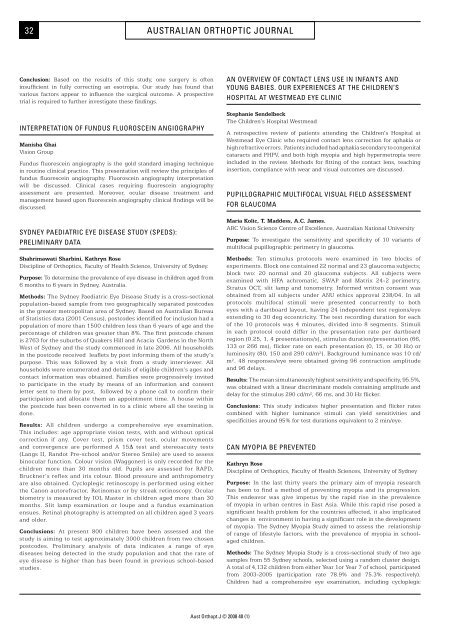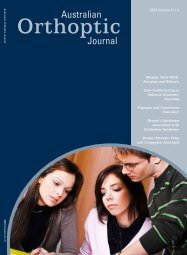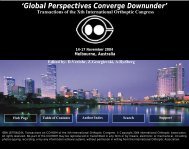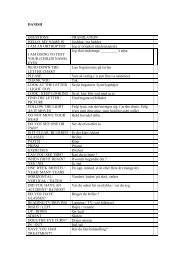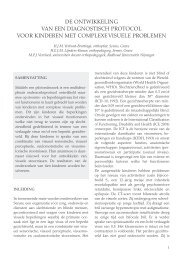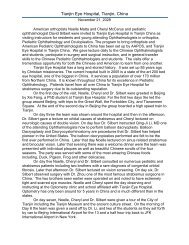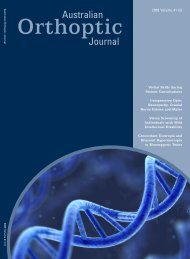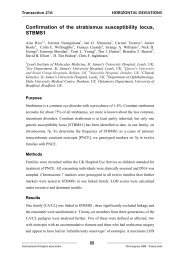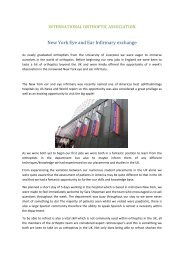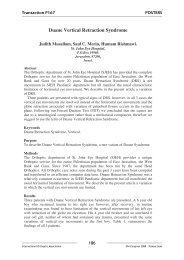Advertising in the Australian Orthoptic Journal - International ...
Advertising in the Australian Orthoptic Journal - International ...
Advertising in the Australian Orthoptic Journal - International ...
You also want an ePaper? Increase the reach of your titles
YUMPU automatically turns print PDFs into web optimized ePapers that Google loves.
32<br />
australian orthoptic journal<br />
Conclusion: Based on <strong>the</strong> results of this study, one surgery is often<br />
<strong>in</strong>sufficient <strong>in</strong> fully correct<strong>in</strong>g an esotropia. Our study has found that<br />
various factors appear to <strong>in</strong>fluence <strong>the</strong> surgical outcome. A prospective<br />
trial is required to fur<strong>the</strong>r <strong>in</strong>vestigate <strong>the</strong>se f<strong>in</strong>d<strong>in</strong>gs.<br />
INTERpretation of fundus fluorosce<strong>in</strong> angiography<br />
Manisha Ghai<br />
Vision Group<br />
Fundus fluoresce<strong>in</strong> angiography is <strong>the</strong> gold standard imag<strong>in</strong>g technique<br />
<strong>in</strong> rout<strong>in</strong>e cl<strong>in</strong>ical practice. This presentation will review <strong>the</strong> pr<strong>in</strong>ciples of<br />
fundus fluoresce<strong>in</strong> angiography. Fluorosce<strong>in</strong> angiography <strong>in</strong>terpretation<br />
will be discussed. Cl<strong>in</strong>ical cases requir<strong>in</strong>g fluoresce<strong>in</strong> angiography<br />
assessment are presented. Moreover, ocular disease treatment and<br />
management based upon fluoresce<strong>in</strong> angiography cl<strong>in</strong>ical f<strong>in</strong>d<strong>in</strong>gs will be<br />
discussed.<br />
SYDNEY PAEDIATRIC EYE DISEASE STUDY (SPEDS):<br />
PRELIMINARY DATA<br />
Shahrimawati Sharb<strong>in</strong>i, Kathryn Rose<br />
Discipl<strong>in</strong>e of <strong>Orthoptic</strong>s, Faculty of Health Science, University of Sydney.<br />
Purpose: To determ<strong>in</strong>e <strong>the</strong> prevalence of eye disease <strong>in</strong> children aged from<br />
6 months to 6 years <strong>in</strong> Sydney, Australia.<br />
Methods: The Sydney Paediatric Eye Disease Study is a cross-sectional<br />
population-based sample from two geographically separated postcodes<br />
<strong>in</strong> <strong>the</strong> greater metropolitan area of Sydney. Based on <strong>Australian</strong> Bureau<br />
of Statistics data (2001 Census), postcodes identified for <strong>in</strong>clusion had a<br />
population of more than 1500 children less than 6 years of age and <strong>the</strong><br />
percentage of children was greater than 8%. The first postcode chosen<br />
is 2763 for <strong>the</strong> suburbs of Quakers Hill and Acacia Gardens <strong>in</strong> <strong>the</strong> North<br />
West of Sydney and <strong>the</strong> study commenced <strong>in</strong> late 2006. All households<br />
<strong>in</strong> <strong>the</strong> postcode received leaflets by post <strong>in</strong>form<strong>in</strong>g <strong>the</strong>m of <strong>the</strong> study’s<br />
purpose. This was followed by a visit from a study <strong>in</strong>terviewer. All<br />
households were enumerated and details of eligible children’s ages and<br />
contact <strong>in</strong>formation was obta<strong>in</strong>ed. Families were progressively <strong>in</strong>vited<br />
to participate <strong>in</strong> <strong>the</strong> study by means of an <strong>in</strong>formation and consent<br />
letter sent to <strong>the</strong>m by post, followed by a phone call to confirm <strong>the</strong>ir<br />
participation and allocate <strong>the</strong>m an appo<strong>in</strong>tment time. A house with<strong>in</strong><br />
<strong>the</strong> postcode has been converted <strong>in</strong> to a cl<strong>in</strong>ic where all <strong>the</strong> test<strong>in</strong>g is<br />
done.<br />
Results: All children undergo a comprehensive eye exam<strong>in</strong>ation.<br />
This <strong>in</strong>cludes: age appropriate vision tests, with and without optical<br />
correction if any. Cover test, prism cover test, ocular movements<br />
and convergence are performed A 15∆ test and stereoacuity tests<br />
(Langs II, Randot Pre-school and/or Stereo Smile) are used to assess<br />
b<strong>in</strong>ocular function. Colour vision (Waggoner) is only recorded for <strong>the</strong><br />
children more than 30 months old. Pupils are assessed for RAPD,<br />
Bruckner’s reflex and iris colour. Blood pressure and anthropometry<br />
are also obta<strong>in</strong>ed. Cycloplegic ret<strong>in</strong>oscopy is performed us<strong>in</strong>g ei<strong>the</strong>r<br />
<strong>the</strong> Canon autorefractor, Ret<strong>in</strong>omax or by streak ret<strong>in</strong>oscopy. Ocular<br />
biometry is measured by IOL Master <strong>in</strong> children aged more than 30<br />
months. Slit lamp exam<strong>in</strong>ation or loupe and a fundus exam<strong>in</strong>ation<br />
ensues. Ret<strong>in</strong>al photography is attempted on all children aged 3 years<br />
and older.<br />
Conclusions: At present 800 children have been assessed and <strong>the</strong><br />
study is aim<strong>in</strong>g to test approximately 3000 children from two chosen<br />
postcodes. Prelim<strong>in</strong>ary analysis of data <strong>in</strong>dicates a range of eye<br />
diseases be<strong>in</strong>g detected <strong>in</strong> <strong>the</strong> study population and that <strong>the</strong> rate of<br />
eye disease is higher than has been found <strong>in</strong> previous school-based<br />
studies.<br />
AN OVERVIEW OF CONTACT LENS USE IN INFANTS AND<br />
YOUNG BABIES. OUR EXPERIENCES AT THE CHILDREN’S<br />
HOSPITAL AT WESTMEAD EYE CLINIC<br />
Stephanie Sendelbeck<br />
The Children’s Hospital Westmead<br />
A retrospective review of patients attend<strong>in</strong>g <strong>the</strong> Children’s Hospital at<br />
Westmead Eye Cl<strong>in</strong>ic who required contact lens correction for aphakia or<br />
high refractive errors. Patients <strong>in</strong>cluded had aphakia secondary to congenital<br />
cataracts and PHPV, and both high myopia and high hypermetropia were<br />
<strong>in</strong>cluded <strong>in</strong> <strong>the</strong> review. Methods for fitt<strong>in</strong>g of <strong>the</strong> contact lens, teach<strong>in</strong>g<br />
<strong>in</strong>sertion, compliance with wear and visual outcomes are discussed.<br />
PUPILLOGRAPHIC MULTIFOCAL VISUAL FIELD ASSESSMENT<br />
FOR GLAUCOMA<br />
Maria Kolic, T. Maddess, A.C. James.<br />
ARC Vision Science Centre of Excellence, <strong>Australian</strong> National University<br />
Purpose: To <strong>in</strong>vestigate <strong>the</strong> sensitivity and specificity of 10 variants of<br />
multifocal pupillographic perimetry <strong>in</strong> glaucoma.<br />
Methods: Ten stimulus protocols were exam<strong>in</strong>ed <strong>in</strong> two blocks of<br />
experiments. Block one conta<strong>in</strong>ed 22 normal and 23 glaucoma subjects;<br />
block two: 20 normal and 20 glaucoma subjects. All subjects were<br />
exam<strong>in</strong>ed with HFA achromatic, SWAP and Matrix 24-2 perimetry,<br />
Stratus OCT, slit lamp and tonometry. Informed written consent was<br />
obta<strong>in</strong>ed from all subjects under ANU ethics approval 238/04. In all<br />
protocols multifocal stimuli were presented concurrently to both<br />
eyes with a dartboard layout, hav<strong>in</strong>g 24 <strong>in</strong>dependent test regions/eye<br />
extend<strong>in</strong>g to 30 deg eccentricity. The test record<strong>in</strong>g duration for each<br />
of <strong>the</strong> 10 protocols was 4 m<strong>in</strong>utes, divided <strong>in</strong>to 8 segments. Stimuli<br />
<strong>in</strong> each protocol could differ <strong>in</strong> <strong>the</strong> presentation rate per dartboard<br />
region (0.25, 1, 4 presentations/s), stimulus duration/presentation (66,<br />
133 or 266 ms), flicker rate on each presentation (0, 15, or 30 Hz) or<br />
lum<strong>in</strong>osity (80, 150 and 290 cd/m²). Background lum<strong>in</strong>ance was 10 cd/<br />
m². 48 responses/eye were obta<strong>in</strong>ed giv<strong>in</strong>g 96 contraction amplitude<br />
and 96 delays.<br />
Results: The mean simultaneously highest sensitivity and specificity, 95.5%,<br />
was obta<strong>in</strong>ed with a l<strong>in</strong>ear discrim<strong>in</strong>ant models conta<strong>in</strong><strong>in</strong>g amplitude and<br />
delay for <strong>the</strong> stimulus 290 cd/m², 66 ms, and 30 Hz flicker.<br />
Conclusions: This study <strong>in</strong>dicates higher presentation and flicker rates<br />
comb<strong>in</strong>ed with higher lum<strong>in</strong>ance stimuli can yield sensitivities and<br />
specificities around 95% for test durations equivalent to 2 m<strong>in</strong>/eye.<br />
CAN MYOPIA BE PREVENTED<br />
Kathryn Rose<br />
Discipl<strong>in</strong>e of <strong>Orthoptic</strong>s, Faculty of Health Sciences, University of Sydney<br />
Purpose: In <strong>the</strong> last thirty years <strong>the</strong> primary aim of myopia research<br />
has been to f<strong>in</strong>d a method of prevent<strong>in</strong>g myopia and its progression.<br />
This endeavor was give impetus by <strong>the</strong> rapid rise <strong>in</strong> <strong>the</strong> prevalence<br />
of myopia <strong>in</strong> urban centres <strong>in</strong> East Asia. While this rapid rise posed a<br />
significant health problem for <strong>the</strong> countries affected, it also implicated<br />
changes <strong>in</strong> environment <strong>in</strong> hav<strong>in</strong>g a significant role <strong>in</strong> <strong>the</strong> development<br />
of myopia. The Sydney Myopia Study aimed to assess <strong>the</strong> relationship<br />
of range of lifestyle factors, with <strong>the</strong> prevalence of myopia <strong>in</strong> schoolaged<br />
children.<br />
Methods: The Sydney Myopia Study is a cross-sectional study of two age<br />
samples from 55 Sydney schools, selected us<strong>in</strong>g a random cluster design.<br />
A total of 4,132 children from ei<strong>the</strong>r Year 1or Year 7 of school, participated<br />
from 2003-2005 (participation rate 78.9% and 75.3% respectively).<br />
Children had a comprehensive eye exam<strong>in</strong>ation, <strong>in</strong>clud<strong>in</strong>g cycloplegic<br />
Aust Orthopt J © 2008 40 (1)


